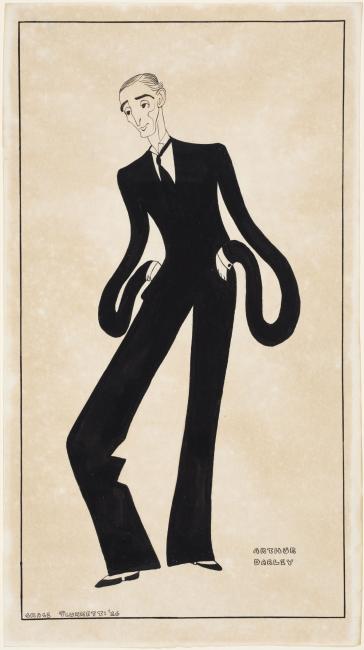Grace Evelyn Gifford
Grace Evelyn Gifford (1888–1955) was an Irish cartoonist, caricaturist, illustrator, and political activist. She published her cartoons in popular periodicals such as Irish Life, Irish Fun, The Shanachie, and The Irish Review. The latter was edited by the revolutionary Joseph Mary Plunkett (1887–1916) whom Gifford married in Kilmainham Gaol only a few hours before he was executed for his part in the 1916 Easter Rising. Gifford converted to Catholicism and became increasingly active in the Irish Republican movement. She was elected to the Sinn Féin executive in 1917 and she also joined the Irishwomen’s Franchise League, working alongside Constance Markievicz (1868 -1927). Gifford’s political interests influenced her artworks, which often reflected and promoted Sinn Féin policies and featured in nationalist ephemera.
Don’t dream of letting your great gift slumber. Keep on making your wonderful distorted mirrors of those you see around.
Joseph Holloway's advice to Grace Gifford
A New Commission
Gifford earned income from commissions and portraits also, as indicated in a handwritten letter to musician Arthur Darley, which she penned from 33 Westmoreland Street, Dublin on 9 August 1926. She writes that ‘Mr Holloway has asked me to do a sketch of you’. Mr Holloway is almost certainly the theatre critic, architect and art collector, Joseph Holloway (1861–1944), who commissioned numerous drawings and cartoons by Gifford, and helped her send cartoons to an exhibition of Irish Art at Whitechapel in London, and to the first exhibition of the Black-and-White Artists Society of Ireland in 1913.
Gifford writes that the sitting will be ‘brief - ten minutes at most’ as she does ‘not know [Darley’s] appearance well enough to do it from memory’. The resulting portrait exaggerates Darley’s height and slim build; the sharp, angular lines of his trousers contrast dramatically with the dynamic curves of his elongated arms that hint at his talent as a virtuoso violinist. The physical distortion and gentle humour are highly characteristic of Gifford’s work, which shows the influence of caricaturist Max Beerbohm (1872–1956) and illustrator Charles Keene (1823–1891).
Arthur Warren Darley
Arthur Warren Darley (1873–1929) was a celebrated classical violinist, traditional Irish fiddler, and an important advocate for the promotion of Irish music. He was a former president of An Ceol Cumann (The Irish Music Club), and was on the central committee of the Feis Ceoil Association, performing and adjudicating at county Feiseanna all over Ireland. Darley was also a Senior Professor at the Leinster School of Music, and lectured for many branches of the Gaelic League. He lectured and performed at the 1922 Irish Race Congress in Paris, alongside other prominent figures in the promotion of Irish culture, including Jack and William Butler Yeats, Evelyn Gleeson and Douglas Hyde.
Irish Volunteer and tenor Gerard Crofts – a friend and fellow performer at the 1922 Irish Race Congress – wrote an obituary for Darley in the Republican newspaper An Phoblacht in January 1930. He described Darley as ‘a consistent Republican’, who subscribed to Republican funds, sheltered men on the run during the War of Independence and had been a popular performer for many years at the Easter Week commemorations held in the Theatre Royal. Sadly, no recordings were ever made of Arthur Darley’s playing – but his legacy is celebrated by the Feis Ceoil’s Arthur Darley Memorial Prize for unaccompanied violin played from memory.
Grania, Bean Ṡeosaiṁ Uí Pluingcéid
Like other Irish nationalists of the period, including Countess Markievicz and Pádraig Pearse, Gifford opens and closes her letter in the Irish language. The greeting ‘A ċara' (my friend) was and remains widely used in Irish letter-writing, even in formal circumstances. Signing off ‘Mise le meas mór’ (yours very respectfully/sincerely), Gifford refers to herself in both Irish and English as ‘Mrs Joseph Plunkett’, honouring her late husband. Gifford remained an active presence in Irish art until her death in 1955. She is buried in Glasnevin Cemetery, close to the republican plot and her husband.
Grace Gifford's letters and drawings feature in the Decade of Centenaries exhibition, Roller Skates & Ruins, on view in Room 11 at the National Gallery of Ireland until 10 March 2024.
Further Reading
Anne Clare, Unlikely Rebels: the Gifford Girls and the Fight for Irish Freedom, Cork: Mercier Press, 2011.
Gerard Crofts, 'Arthur Warren Darley: An Appreciation of Ireland's Gifted Musician', An Phoblacht, 11 January 1930
Hilary Pyle, ‘Comedy’s Ill-fated Muse’, Irish Arts Review, Summer 2014
Donna Rose and Marie Lynch, ESB CSIA Fellows
Published online: 2022

